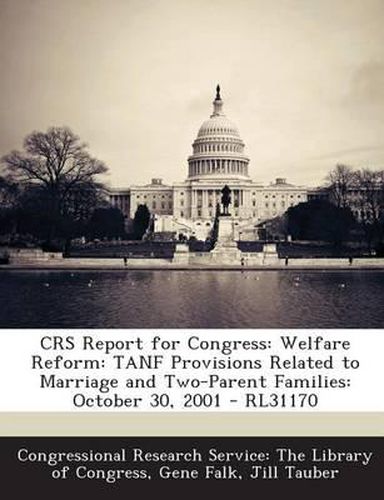Readings Newsletter
Become a Readings Member to make your shopping experience even easier.
Sign in or sign up for free!
You’re not far away from qualifying for FREE standard shipping within Australia
You’ve qualified for FREE standard shipping within Australia
The cart is loading…






The impact of welfare policies on discouraging or encouraging marriage has long been a topic of discussion. Welfare programs, by providing single parents with the economic means to support their children, are thought to discourage marriage. Federal policies in place before the 1996 welfare reform law restricted the use of federal funding for cash aid for needy families with children with two able-bodied parents in the home. The Temporary Assistance for Needy Families (TANF) block grant, created in the 1996 welfare reform law (P.L. 104-193), ended federal constraints on aid to two-parent families. TANF goes further, however, by establishing a statutory goal to promote the formation and maintenance of two-parent families. States may spend TANF funds on a wide range of activities (services) for cash welfare recipients and other families toward the achievement of this goal. Moreover, TANF has a \“High Performance Bonus\” that, beginning in FY2002, will pay a total of $10 million to the 10 states with the greatest increase in the percent of children living in married couple families. TANF does, however, have an especially high work participation requirement for two-parent families receiving cash welfare: in FY2002, 90% of two-parent families, compared with 50% of all families, …
$9.00 standard shipping within Australia
FREE standard shipping within Australia for orders over $100.00
Express & International shipping calculated at checkout
The impact of welfare policies on discouraging or encouraging marriage has long been a topic of discussion. Welfare programs, by providing single parents with the economic means to support their children, are thought to discourage marriage. Federal policies in place before the 1996 welfare reform law restricted the use of federal funding for cash aid for needy families with children with two able-bodied parents in the home. The Temporary Assistance for Needy Families (TANF) block grant, created in the 1996 welfare reform law (P.L. 104-193), ended federal constraints on aid to two-parent families. TANF goes further, however, by establishing a statutory goal to promote the formation and maintenance of two-parent families. States may spend TANF funds on a wide range of activities (services) for cash welfare recipients and other families toward the achievement of this goal. Moreover, TANF has a \“High Performance Bonus\” that, beginning in FY2002, will pay a total of $10 million to the 10 states with the greatest increase in the percent of children living in married couple families. TANF does, however, have an especially high work participation requirement for two-parent families receiving cash welfare: in FY2002, 90% of two-parent families, compared with 50% of all families, …